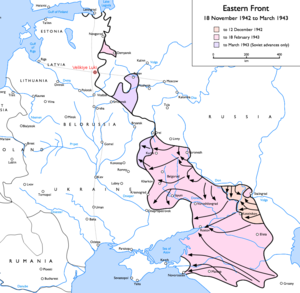
Back Bitva o Velikije Luki Czech Schlacht von Welikije Luki German Velikije Luki operatsioon Estonian نبرد ولیکیه لوکی Persian Velikije Lukin taistelu Finnish Bataille de Velikié Louki French Slaget ved Velikiye Luki NB Batalha de Velikiye Luki Occitan Bătălia de la Velikie Luki Romanian Великолукская наступательная операция Russian
This article includes a list of general references, but it lacks sufficient corresponding inline citations. (October 2008) |
| Battle of Velikiye Luki | |||||||
|---|---|---|---|---|---|---|---|
| Part of the Eastern Front of World War II | |||||||
 Velikiye Luki (red, upper left) and the nearby rail trunks, in the context of the Soviet 1942–1943 offensives. (click to enlarge) | |||||||
| |||||||
| Belligerents | |||||||
|
|
| ||||||
| Commanders and leaders | |||||||
|
|
| ||||||
| Strength | |||||||
|
LIX Korps – ~50,000 (on 19 Nov) Reinforcement forces: ~50,000[1] |
3rd Shock Army – 95,608 (on 19 Nov) Reinforcement forces: 86,700[2] | ||||||
| Casualties and losses | |||||||
|
Western estimate:[3] 5,000 KIA and MIA; 15,000 WIA Soviet estimate: ~60,000 killed, missing or wounded, 4,500 captured[4] |
104,022 31,674 killed or missing 72,348 wounded[5] | ||||||

The Battle of Velikiye Luki, also named Velikiye Luki offensive operation (Russian: Великолукская наступательная операция), started with the attack by the forces of the Red Army's Kalinin Front against the Wehrmacht's 3rd Panzer Army during the Winter Campaign of 1942–1943 with the objective of liberating the Russian city of Velikiye Luki as a previous part of the northern pincer of the Rzhev-Sychevka Strategic Offensive Operation (Operation Mars).
Sometimes known as "The Little Stalingrad of the North", the Soviet forces encircled the city on 27 November 1942, but were unable to make much progress against German units further west nor retake a key railway to Leningrad. The German garrison in the city was ordered to hold out for a relief force and put up a concerted defense. As was the case at Stalingrad, repeated German counterattacks were unable to reach the city, and the garrison surrendered on 16 January 1943.
- ^ Oldwitg von Natzmer. Operations of Encircled Forces. German Experiences in Russia. – Department of the Army, Washington, DC 1952. (Oldwitg von Natzmer). Washington DC. 1952
- ^ Галицкий К. Н. Годы суровых испытаний. 1941—1944 (записки командарма) – М.: Наука, 1973. стр.185
- ^ R. Forczyk, VELIKIYE LUKI 1942–43, 2020, p. 90
- ^ Великая Отечественная война. 1941—1945 гг. Справочное пособие/ Автор-составитель И. И. Максимов. – М.: Издательство «ДИК», 2005. ISBN 5-8213-0232-3
- ^ Glantz (1995), p. 296